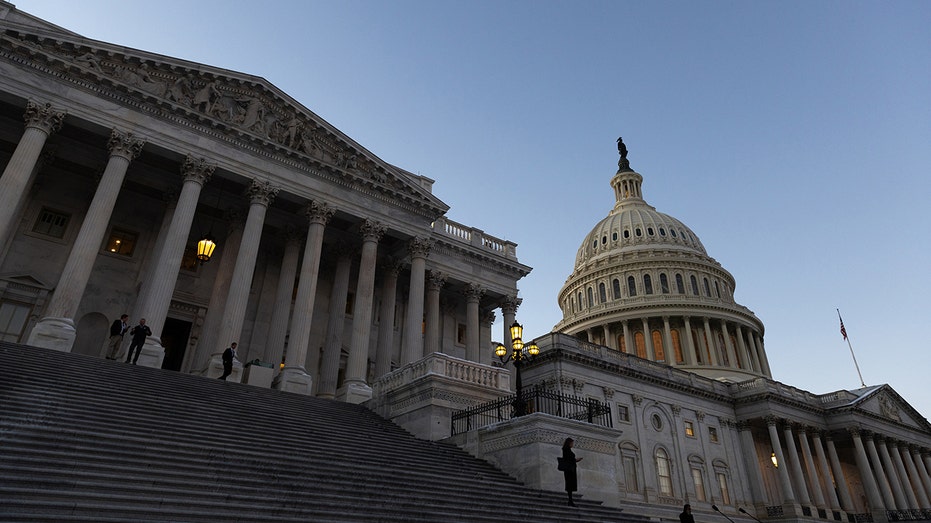National Debt Tracker: American taxpayers (you) are now on the hook for $38,378,996,619,785.02 as of 12/18/25
Track the rapid rise in the US national debt, and see how much taxpayers (you) owe
What is the national debt?
Economist Peter Morici breaks down what the national debt is, why it ballooned to more than $34 trillion and what it means for Americans.
The U.S. national debt is climbing at a rapid pace and has shown no signs of slowing down despite the growing criticism of massive levels of government spending.
The national debt, which measures what the U.S. owes its creditors, fell to $38,378,996,619,785.02 as of Dec. 18, according to the latest numbers published by the Treasury Department. That is a decrease of about $17 billion from the figure reported the previous day.
By comparison, just four decades ago, the national debt hovered around $907 billion.
Interest payments on the debt for the government's fiscal year, which begins in October, now exceed the costs of Medicare and the defense budget.
CBO SAYS US BUDGET DEFICITS TO WIDEN, NATIONAL DEBT TO SURGE TO 156% OF GDP
The outlook for the federal debt level is bleak, with economists increasingly sounding the alarm over the torrid pace of spending by Congress and the White House.
This has intensified with the recent passage of President Donald Trump's One Big Beautiful Bill Act, which the nonpartisan Congressional Budget Office (CBO) estimates will add $3.4 trillion to budget deficits over the next decade. Trump's team argues revenues from tariffs and faster economic growth will more than help offset rising debt.
The latest findings from the CBO indicate that the national debt will grow to an astonishing $54 trillion in the next decade, the result of an aging population and rising federal healthcare costs. Higher interest rates are also compounding the impact of higher debt.
LARGE DEFICITS, HIGH INTEREST RATES MAKING FEDERAL DEBT LESS SUSTAINABLE
Should that debt materialize, it could risk America's economic standing in the world.
"America’s fiscal outlook is more dangerous and daunting than ever, threatening our economy and the next generation," said Michael Peterson, the CEO of the Peter G. Peterson Foundation, which advocates for reducing the federal deficit. "This is not the future any of us want, and it’s no way to run a great nation like ours."
The unrelenting increase is what prompted Fitch Ratings to issue a surprise downgrade of the nation's long-term credit score in mid-2023. The agency cut the U.S. debt by one notch, snatching away its pristine AAA rating in exchange for an AA+ grade. In making the decision, Fitch cited alarm over the country's deteriorating finances and expressed concerns over the government's ability to address the ballooning debt burden amid sharp political divisions.
"This is a warning shot across the U.S. government's bow that it needs to right its fiscal ship," Sean Snaith, an economist at the University of Central Florida, told FOX Business. "You can't just spend trillions of dollars more than you have in revenue every year and expect no ill consequences."
MOODY'S DOWNGRADED US CREDIT RATING: WHAT DOES THAT MEAN?
In May, Moody's Ratings became the third of the three major ratings agencies to downgrade the U.S. credit rating from its highest tier, lowering it from Aaa to Aa1 on its 21-notch scale. The firm noted that the cost of interest payments on the debt is projected to rise from 9% of federal revenue to 30% of federal revenue by 2035.
"Successive U.S. administrations and Congress have failed to agree on measures to reverse the trend of large annual fiscal deficits and growing interest costs," Moody's wrote.
Rising interest expenses from servicing the more than $36 trillion national debt follow a burst of spending by former President Joe Biden and Democratic lawmakers as interest rates rose in response to inflation hitting a 40-year high in 2022.
By September 2022, after a little more than a year and a half in office, Biden had already approved roughly $4.8 trillion in borrowing, including $1.85 trillion for a COVID relief measure, the American Rescue Plan, and $370 billion for the bipartisan infrastructure bill, according to the Committee for a Responsible Federal Budget (CRFB), a group that advocates for reducing the deficit.
SOARING DEFICITS TO PUSH PUBLICLY HELD DEBT TO RECORD LEVEL IN 4 YEARS
Biden repeatedly defended the spending by his administration and boasted about cutting the deficit by $1.7 trillion during his term.
However, that figure refers to a reduction in the national deficit between fiscal years 2020 and 2022. While the deficit did shrink during that time period, that is largely because emergency measures put into place during the COVID-19 pandemic expired.
THE US IS PAYING A RECORD AMOUNT OF INTEREST ON ITS NATIONAL DEBT
During Trump's first term, the national debt grew by about $7.5 trillion, in part due to the onset of the COVID-19 pandemic, which prompted Congress and the administration to enact fiscal stimulus aimed at supporting American households and businesses amid the uncertainty.
The budget deficit for fiscal year 2020 came in at a whopping $3.1 trillion due to those measures, which was the largest annual deficit in U.S. history.
The second-largest deficit occurred the following year in fiscal year 2021, which spanned the end of Trump's first term and the beginning of Biden's term, when the deficit reached over $2.7 trillion.
Even more worrisome is that the spike in interest rates in recent years has made the cost of servicing the national debt more expensive on the heels of those historic deficits.
That is because as interest rates rise, the federal government's borrowing costs on its debt will also increase. In fact, interest payments on the national debt are projected to be the fastest-growing part of the federal budget over the next three decades, according to the CBO.
US NATIONAL DEBT HITS A NEW RECORD: $36 TRILLION

The U.S. Capitol in Washington, D.C. (Julia Nikhinson/Bloomberg via Getty Images)
The CBO's 2025 long-term budget outlook projected that federal spending on interest expenses will rise from about 3.1% of gross domestic product (GDP) in fiscal year 2024 to about 5.3% of GDP in 2054.
"We are clearly on an unsustainable fiscal path," CRFB President Maya MacGuineas said. "We need to do better."
While the debt has been a source of concern among politicians and budget hawks, just how worried should you be about the nation's rapid pace of borrowing?
CLICK HERE TO READ MORE ON FOX BUSINESS
A larger national debt and the higher cost of servicing it mean that those expenses can crowd out federal spending on other areas that fuel economic growth, like education, research and development, and infrastructure.
"A nation saddled with debt will have less to invest in its own future," the Peter G. Peterson Foundation said.
A Pew Research Center survey published in 2023 found that 57% of Americans think reducing the budget deficit should be a top priority for the president and Congress, up from just 45% the previous year.




















